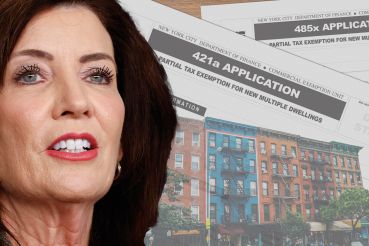Year end leasing data unveiled this morning by the real estate services firm Cushman & Wakefield (CWK) showed a host of impressive measures of the Manhattan office market: vacancy dropped, rents rose modestly and more space has been leased in over a decade.
Yet, in spite of the encouraging figures and what is clearly the strongest performance by the market since the recession, uncertainties loom.

Namely, the demand for large sized deals – a major driver of the Manhattan market – appears to have fallen relative to supply from 2010. According to C&W’s figures, 16 spaces with 250,000 square feet or larger were available at the end of 2011 in midtown compared to just nine in 2010. And while there were 26 potential takers in the market a year ago, C&W counts fewer now, 22.
“Yes we’ve heard the talk that financial services firms could shed jobs or reduce in size but it’s not clear how that’s going to sort itself out,” said Joseph Harbert, C&W’s chief operating officer, who led the company’s presentation this morning in midtown.
A leaner, less space-hungry financial sector could be a substantial headwind for the Manhattan market just as it appears to be gaining steam. On average, financial firms lease a third of the city’s roughly 400 million square feet of offices, making it by far the largest space-using industry.
As The Commercial Observer reported this morning, Bank of America (BAC) just signed a renewal deal at 114 West 47th Street, an office building it occupies in midtown. The bank however is taking about 360,000 square feet in the lease, far less than the roughly 600,000 square feet it previously occupied. Last summer Bank of America also substantially reduced the amount of square feet it has at downtown’s World Financial Center, an office complex where its subsidiary Merrill Lynch had three million square feet. Bank of America renewed only about 750,000 square feet at the complex in that deal.
Rumors have swirled that the Swiss bank UBS, once a candidate to anchor a new office tower at the World Trade Center site, may end up subleasing space or reducing its footprint at locations it has in midtown. Other European financial institutions battered by the debt crisis on that continent have also spurred speculation that they will cast sublease space on the market, though that scenario has yet to show sure signs of playing out.
Already Midtown South has increasingly become an area less reliant on financial tenants, though it has long been a neighborhood that caters to other industries. According to C&W’s data, half the square feet leased in the neighborhood in 2011, was taken by media and information firms, the highest tally for that industry on record C&W said. Advertising tenants were the second most voracious taker of space. Hudson Square was one of the market’s main benefactors of the activity. At 13.9 percent, vacancy was still higher in Hudson Square than anywhere else in Midtown South, but also saw the greatest decline, falling 3.4 percent during the year. Rents also rose the most on average in Hudson Square, jumping by 6.9 percent during the year, and the increase in leasing activity was higher there than anywhere else in Midtown South, rising by nearly double since 2010 with 1.1 million square feet taken during the year.
“Information and media took up the slack if there were any shortfalls from other industries,” Mr. Harbert said, saying that that sector’s appetite is evidence of the way that Manhattan has in recent years begun to appeal to a wider variety of industries that now supplements the city’s traditional space takers.
Overall, 38.3 million square feet of space was rented during 2011, the most space leased in Manhattan in over a decade. The activity drove Manhattan’s vacancy rate down by 1.4 percent during the year to 9.1 percent. 4.3 million square feet of space was absorbed during the year, a telling measure that indicates the net demand for offices now outweighs the supply being added to the market. Still, rents have yet to rise meaningfully. Average rents were $57.23 per square foot according to C&W, a modest 5.3 percent increase over last year. Mr. Harbert said that net effective rents, a figure that factors in concessions given by the landlord, were $56.47 per square foot, up from a low during the recession of $49.77 per square foot but still well below the peak set before the downturn of $88.79 per square foot.
“What we say is the market needs to get to seven or eight percent vacancy range for landlords to have the power to really raise rates,” Josh Kuriloff, an executive at C&W said. “I do work around the U.S. and to sit here though and be talking about vacancy rates that are well below 10 percent is just phenomenal.”
“I think this market could be poised for a rental spike in the next 24 months,” Mr. Kuriloff added.
DGeiger@Observer.com



